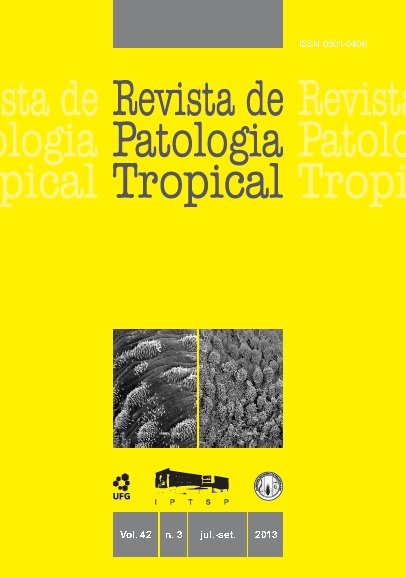TEGUMENTARY CHANGES IN TWO DIFFERENT STRAINS OF Schistosoma mansoni TREATED WITH ARTEMISININ AND ARTESUNIC ACID
DOI:
https://doi.org/10.5216/rpt.v42i3.26930Keywords:
Schistosoma mansoni, BH and SJ Strains, Artemisinin, Artesunic Acid, Scanning Electron MicroscopyAbstract
Different strains of Schistosoma mansoni can respond differently to conventional and experimental treatments. Therefore, the responses to potential schistosomicidal drugs must be checked with different parasite strains. This work aimed to analyze changes caused by different concentrations of artemisinin or artesunic acid administered on different days in the teguments of adult S. mansoni belonging to two Brazilian strains (BH and SJ), using scanning electron microscopy (SEM). Infected mice were treated with 300 or 500 mg/kg of artemisinin and artesunic acid, 30 or 45 days post infection. Fifteen days after treatment, worms were examined by SEM. Altered teguments were observed in males and females on both days of treatment with both compounds, but the injury with artesunic acid was more intense. The treatment utilizing 500 mg/kg of artesunic acid against the BH strain 30 days after the infection proved to be particularly effective, resulting in erosion, peeling, sensory structure damage, and vesicle formation on the tegument of males and females. It is concluded that artemisinin and artesunic acid showed qualitatively similar tegumentary changes in both genders of the BH and SJ parasite strains. However, changes induced by artesunic acid were more severe for the BH strain, which demonstrates greater susceptibility of this strain to this experimental treatment.Downloads
Downloads
How to Cite
Issue
Section
License
The manuscript submission must be accompanied by a letter signed by all authors stating the full name and email address, confirming that the material has not been published or is under consideration for publication elsewhere, and agreeing to transfer copyright in all media and formats for Journal of Tropical Pathology. The authors will not be paid for published articles. They are solely responsible for the content of those articles, even if the Editor holds the right to adjust them to the norms of the journal.
The reviewers will not be paid for the peer review process.

